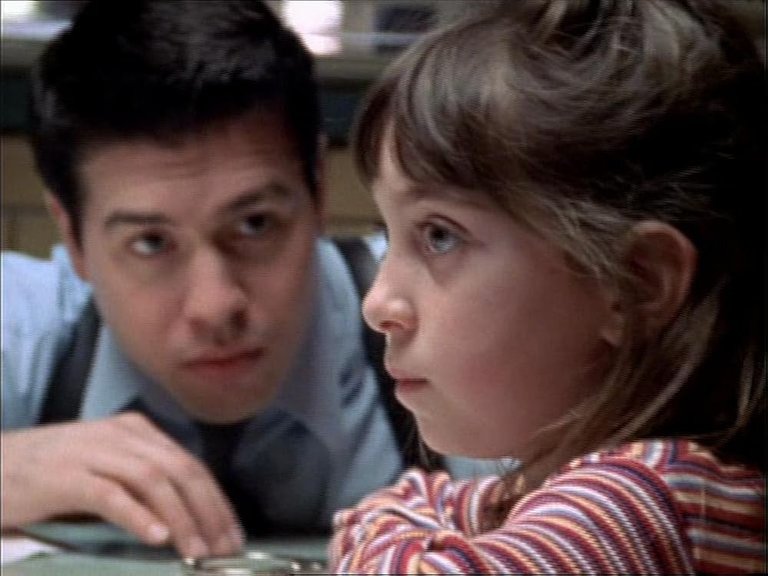Television Review: Abduction (Homicide: Life on the Street, S6X17, 1998)

Abduction (S06E17)
Airdate: 27 March 1998
Written by: Julie Martin & Anya Epstein
Directed by: Kenneth Fink
Running Time: 46 minutes
One of the defining traits of Homicide: Life on the Street was its refusal to pander to audience sentimentality, a quality that frustrated NBC executives during the show’s later seasons as they scrambled to boost flagging ratings. The series’ unflinching portrayal of violent crime and its aftermath made genuinely uplifting endings rare—a consequence of its commitment to realism, not a flaw. For every victim, there were shattered families; for every case closed, there was lingering grief. Yet Abduction, the penultimate episode of Season 6, offers a rare exception. It is a “Very Special Episode” in the tradition of late 1990s TV, tackling a high-stakes child abduction with a resolution that defies the show’s usual bleakness.
Julie Martin and Anya Epstein’s script sidesteps the show’s usual focus on murder by centring a case of child abduction—a “redball” priority for the Baltimore Police Department. The episode opens at a fairground, where dental technician Amy Marshall (Elizabeth Marvel) watches her four-year old son Sean merry-go-round. His sudden disappearance sparks a frantic search, with the Homicide Unit, typically reserved for violent crime, drafted into the case. The investigation unfolds methodically: suspects include her ex-husband David (Bray Poor), and a convicted sex offender lurking near the fair. Both are swiftly cleared, while a false lead emerges from a fame-seeking young man.
The breakthrough comes from Amber (Lauren Haulsey), a seven-year-old witness whose fragmented memories are unlocked via hypnosis, a controversial but effective plot device here. This reveals details about the abductor’s car and licence plate, leading detectives to Sandy Reynolds (Amelia Campbell), a disturbed woman obsessed with adopting Sean. The resolution—Reynolds’ arrest and Sean’s safe return—is textbook “feel-good,” yet the script avoids melodrama by grounding the stakes in procedural detail. The episode’s tension stems not from violence but from the race against time, a shift that highlights the emotional weight of parental desperation and the procedural mechanics of a non-lethal crime.
Abduction’s most notable trait is its absence of death, a radical departure for a show named Homicide. This allows the narrative to focus on the psychological toll of abduction on families and the logistical challenges for law enforcement. The episode avoids the gratuitous sensationalism often seen in “missing child” TV tropes, instead depicting the gruelling process of investigation: media scrutiny, the pressure of public appeals, and the ethical dilemma of using hypnosis on a child witness. The inclusion of Amber’s hypnosis scene, while fictionalised, nods to real investigative techniques, adding a layer of authenticity. Even the resolution feels earned, as the detectives’ persistence—and a stroke of luck—prevail without resorting to deus ex machina.
The standout performance is Elizabeth Marvel as Amy, whose portrayal of a mother’s anguish is visceral yet restrained. Her desperation. By contrast, the supporting cast occasionally leans into Homicide’s established character tropes. Yet Marvel’s nuanced work elevates the episode, making Amy’s journey—from despair to fragile hope—believable and affecting.
The introduction of Jeff Andrews (Robert John Burke), a true crime TV host covering the case, adds a layer of social critique. His character, a thinly veiled analogue of John Walsh of America’s Most Wanted, is initially portrayed as a meddlesome opportunist, with Falsone dismissively sees him as media vulture. However, a revelation that Andrews lost his own daughter to abduction humanises him, transforming him from antagonist to sympathetic figure. His line—“The audience likes happy endings for a change”—is a wry meta-commentary on the episode itself, acknowledging Homicide’s rarity in delivering such an outcome while subtly critiquing TV’s appetite for emotional payoff.
Despite its strengths, Abduction is uneven. The pacing falters in its second half, with subplots about Falsone’s anxieties. These moments divert attention from the central case, particularly Falsone’s repetitive musings about his own fatherhood, which feel out of step with the episode’s urgency. Additionally, the show’s tendency to prioritise character-driven drama over plot momentum occasionally slows the narrative, as internal squabbles among detectives take precedence over the investigation’s procedural beats.
Abduction is a testament to Homicide’s versatility, proving the series could handle unconventional narratives while maintaining its gritty, realistic edge. Though its happy ending breaks from the show’s norm, it does so with enough narrative integrity to avoid feeling tonally jarring. The episode’s strengths—Marvel’s performance, the procedural authenticity, and the sharp social commentary via Jeff Andrews—outweigh its pacing issues and superfluous character moments. It remains a compelling outlier in the series, showcasing Homicide’s ability to adapt without sacrificing its core identity. For all its flaws, Abduction is a reminder that even in its quest for ratings, the show could still deliver thoughtful, emotionally resonant storytelling.
RATING: 7/10 (+++)
Blog in Croatian https://draxblog.com
Blog in English https://draxreview.wordpress.com/
InLeo blog https://inleo.io/@drax.leo
LeoDex: https://leodex.io/?ref=drax
Hiveonboard: https://hiveonboard.com?ref=drax
Rising Star game: https://www.risingstargame.com?referrer=drax
1Inch: https://1inch.exchange/#/r/0x83823d8CCB74F828148258BB4457642124b1328e
BTC donations: 1EWxiMiP6iiG9rger3NuUSd6HByaxQWafG
ETH donations: 0xB305F144323b99e6f8b1d66f5D7DE78B498C32A7
BCH donations: qpvxw0jax79lhmvlgcldkzpqanf03r9cjv8y6gtmk9
The psychological impact and analysis of it makes it have more depth...I find that internal depth approach interesting. Thanks for your review of this episode.